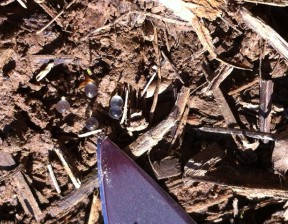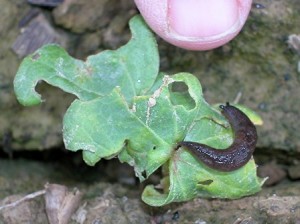I’ve already been getting comments about people seeing slugs in their fields, and the cool and wet weather isn’t helping. Of course, slugs like it wet, and slow seedling growth gives them more time to feed on seedlings before and during emergence. Slugs will be active at temperatures above 50 degrees, which helps them get a jump on crops during cool conditions.
Only expect potential slug problems in no-till fields, and especially those with a lot of residue. Weedy vegetation and cover crops can increase populations, and depending on the weather, keep the soil cool and moist, aggravating the problem. They can feed on and reduce stands in cotton, corn, and soybean.
What can you do about slugs?

First, you can scout for the critters. During my recent turkey hunts, I’ve noticed them crawling across the ground on warmer mornings, and others have told me the same thing. During the day, slugs will typically be under debris or hidden within soil cracks and crevices. An old trick for home gardens and flower beds is to put out small tin cans of beer, which attracts and traps the slugs. We are testing this to see how well this works for sampling and predicting potential slug problems, but currently, we do not have any treatment thresholds other than suggesting to treat when slugs threaten to reduce stands below acceptable levels. And the truth is, slugs population levels is only part of the equation as they are more likely to cause problems when it stays relatively cool and wet.
Treatment options are limited. There are some cultural practices to consider, but these obviously won’t always be an option.
- Tillage, even light tillage (e.g., turbo till), can essentially eliminate the problem by directly killing slugs and reducing the residue they hide under. Serious injury often occurs when seedling plants are covered with residue, and the slugs feed under this residue 24/7.
- Row cleaners can help substantially if set properly. It is also very important that the seed furrow closes during planting. It often stays open when the soil is wet, and this provides a highway for slugs to travel and feed during the day and night.
- Consider increasing your seeding rate by 5-10% when you know slugs may be a problem.

Insecticides do not control slugs. The only pesticides that provide any control are baits containing metaldehyde (e.g., Deadline M-PS) or iron phosphate (e.g., Leaf Life Sluggo). These can work pretty well, even at the minimum rates, providing you do not get substantial rain for a day or two after they are spread. But they are fairly expensive, and getting a supply and figuring out how to spread 10-20 lbs of a dry, pelleted product to large fields is a challenge. You have plan ahead. We are planning some demonstrations this year, and hoping to see if we can get by with reduced rates if we spread the baits earlier. However, this still leaves the challenges of supply and application.
There is some data showing that you can “salt” the slugs with liquid fertilizer applications. I’ve had limited experience with this, but the important steps are to make applications at dusk, and two applications are often recommended. Frankly, I have little confidence in this approach, but the idea is to get these products in direct contact with slugs very soon after application (the soil will quickly buffer the salting effect).
If your interested in getting a second opinion, my colleagues at Mississippi State University beat me to a punch and recently posted an article about slugs (read here), but our experiences and suggestions are very similar. They remind their readers that we are talking specifically about slugs and slugs do not have shells. Remember that snails have shells, and snails rarely cause problems in field crops. Do not treat for snails!


